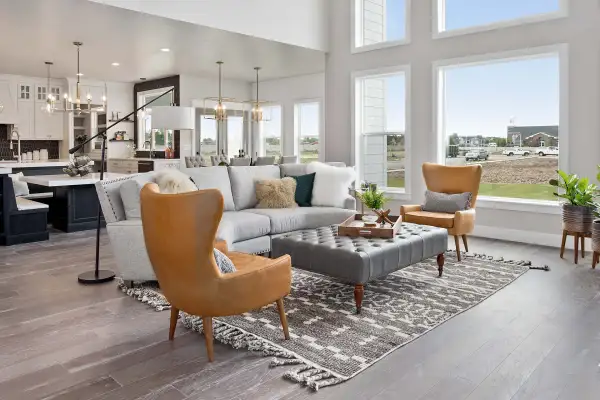Home Sellers: If You're Only Going to Stage One Room, Make It This One

It’s no secret we’re in a seller’s market. And with homes flying off the market and many selling above list price, you might be tempted to put your house up for sale without upgrading your home’s décor. After all, why bother when so many buyers are already clamoring for a low supply of homes?
The reasoning is simple: “No matter how hot the market is, selling a home is all about presentation, and staging is your number one marketing tool when you take listing photos,” says Barb Schwarz, a home decorator and stager in Hawaii.
Staging is the process of primping a home for sale so that it looks its best and appeals to the largest pool of potential buyers. It usually entails adding or rearranging furniture to show off a home’s best assets. And it’s more important now than ever, says Manuela Ferguson, a home stager based in the Washington, D.C. metro area.
“We’re in the age of TikTok and Instagram, where homebuyers are more visually attuned than they’ve ever been,” she says.
Staging can be so effective, in fact, that 31% of listing agents said they stage all homes prior to putting them on the market, according to the National Association of Realtors’ 2021 Profile of Home Staging. The survey also found that 23% of agents reported an increase of 1% to 5% of the dollar value offered by buyers in comparison to un-staged homes, and 18% reported staging increased the dollar value by 6% to 10%.
That’s no small chunk of change. Even nabbing just an extra 1% for a home valued at $300,000 would mean roughly $3,000 extra in the seller’s pocket at closing.
However, you don’t have to stage your home from top to bottom to make your house stand out, Ferguson says. According to the NAR survey, buyers’ agents said the living room was the most important room to stage, followed by the primary bedroom and the kitchen.
“The living room is the place where people gather, and people are spending more time at home with their family than they have in the past because of the pandemic,” Ferguson says. “Every real estate agent that I’ve been working with since the pandemic started wants the living room staged.”
As Warwick, New York-based home stager and decorator Karen Gray-Plaisted says, “If the room where you entertain guests looks beautiful, buyers will think to themselves, ‘This is the home that I want to live in.’”
Staging only the living room can also help you significantly reduce your costs. Stagers typically charge $150 to $600 for an initial design consultation and $500 to $600 per month per staged room when furniture is rented, according to HomeAdvisor. (Fully staging a 2,000-square-foot home usually costs about $2,000 a month.)
Ready to transform your living room? These staging tips — many of which can be applied to other rooms in your home — will make it appealing to the masses.
1. Declutter and depersonalize
Clutter and personal items can be distracting to buyers and make it difficult for buyers to envision living in your home. “Family photos, golf collection, magazines, books — take it all out,” advises Barb Schwarz, a home stager in Hawaii.
But don’t just toss all your stuff into a closet or garage; you want those spaces to be clear as well. Instead, consider renting a storage unit. While prices can vary depending on the size and location, a small storage unit (5-by-5 feet) costs an average of $60 a month to rent, according to storage marketplace Neighbor.com.
This can also be a great time to sell, donate, recycle or trash items you won’t want to lug with you to your next home.
2. Apply a fresh coat of paint (but choose a neutral color)
If your living room walls are crying out for a facelift, a coat of paint can go a long way.
Gray-Plaistet recommends selecting a neutral hue. “Aggressive colors, like red and orange, don’t photograph well,” she says. (You can add pops of color through accessories and artwork.) Traditionally an off-white or gray works well, but Gray-Plaistet suggests keeping up with the latest trend: “Gray is out. Beige is in,” she says.
Moreover, a fresh coat of paint isn’t a large investment — painting a 10-by-12-foot room costs on average $200 to $800, HomeAdvisor reports. DIY painting can cost between $100 and $300.
3. Maximize existing furniture
To keep staging costs down, see if you can rearrange your living room furniture or bring in furniture from another room to make the space more inviting. “A great stager will look at your furniture and see what works well and what doesn’t,” says Sam Jernigan, the owner of Renaissance Design Consultations, an interior design firm in Northern California. “Maybe a chaise lounge can be moved from your den to your living room.”
4. Let your hardwood floors shine
Many homebuyers swoon over hardwood. In fact, homes with wood floors sell faster and for more money than homes without wood floors, according to a survey of real estate agents conducted by the National Wood Flooring Association.
So, if you have hardwood floors that are in good condition, don’t hide them with carpeting or oversized furniture. And if they need a good clean, make sure to use a cleaning product specifically for wood — some multipurpose cleaners can remove the protective coating on top of the wood.
5. Consider hiring a professional stager
Even if you have an eye for interior design, paying a stager can be beneficial. Professional stagers keep their pulse on the latest design trends, and many provide the staging furniture, meaning you don’t have to select and rent furniture on your own.
You can ask your real estate agent to recommend a stager. You can also search for stagers in your area through the Real Estate Staging Association.
More from Money:
5 Affordable Ways to Boost Your Home's Curb Appeal Before You Sell
7 Home Improvement Projects That Actually Pay Off When You Sell
Goodbye Open Houses, Hello TikTok Tours? How Homes Get Sold Now
